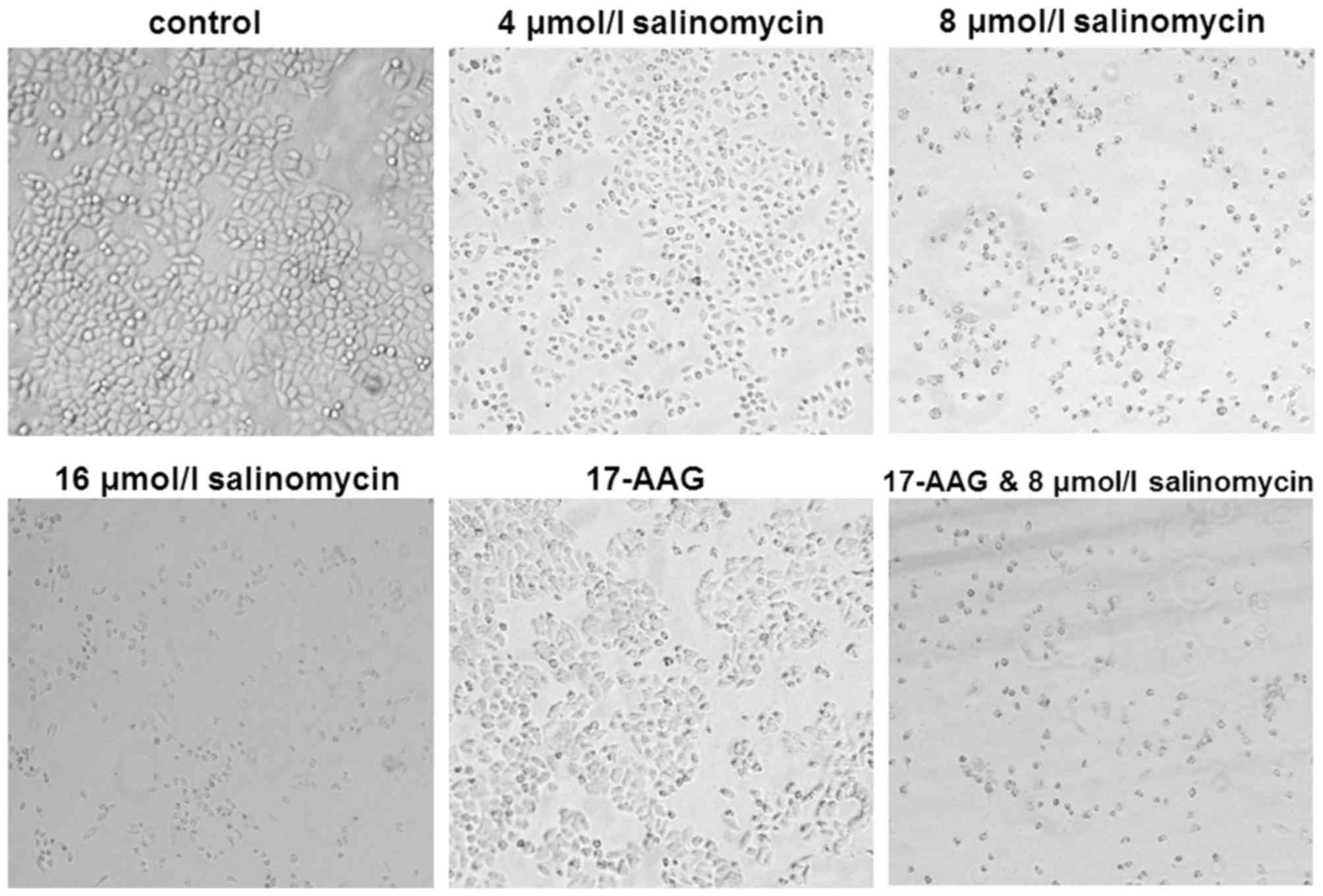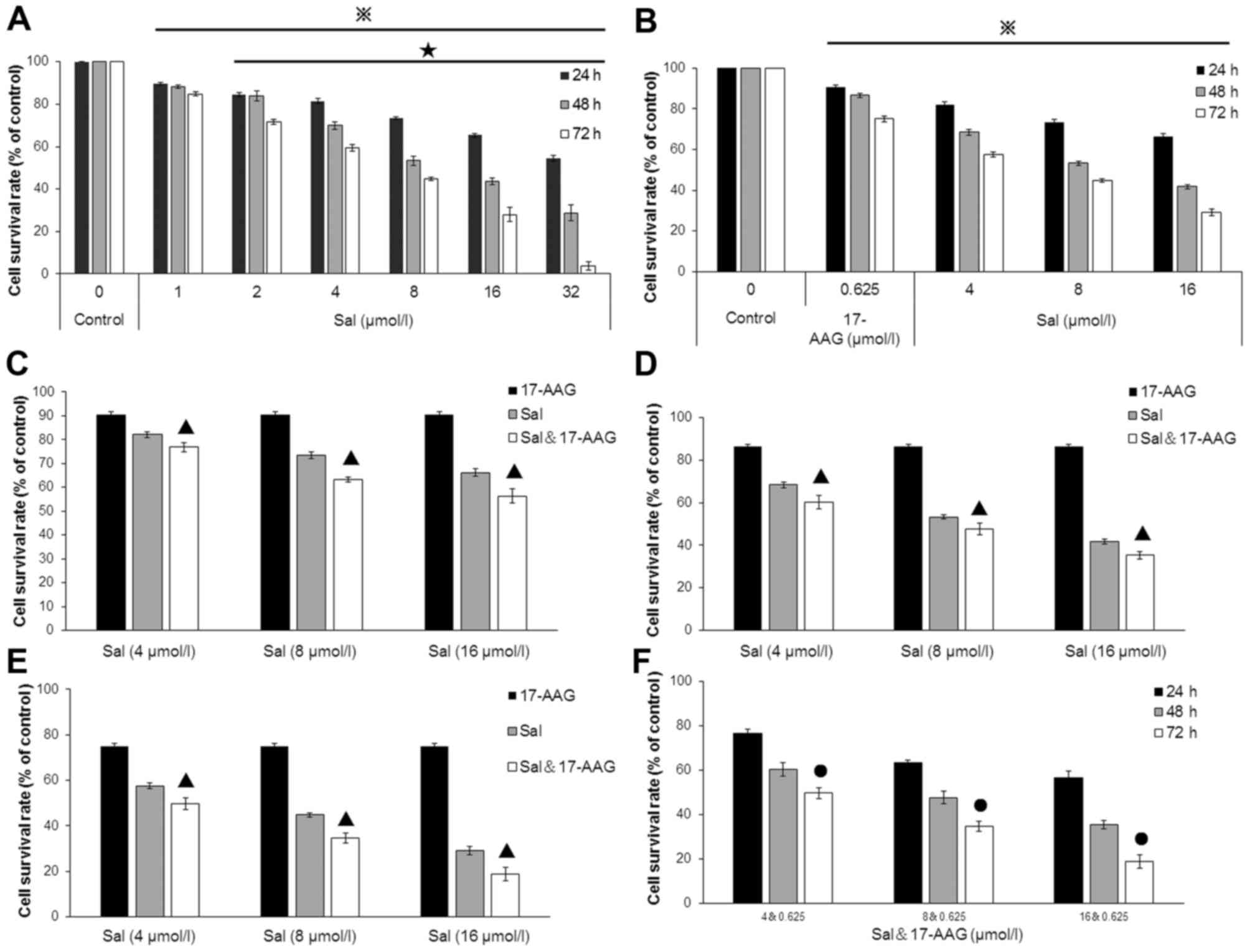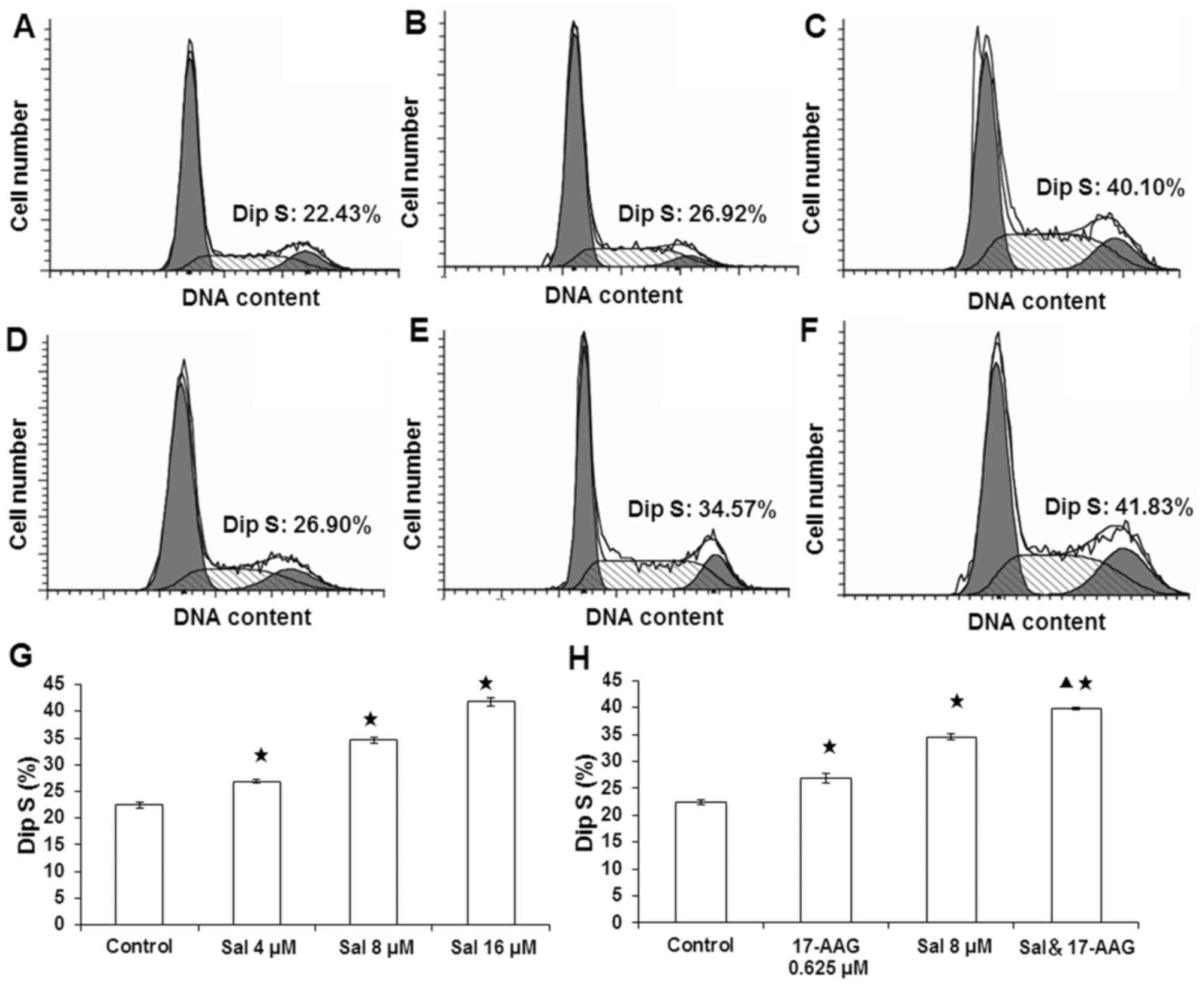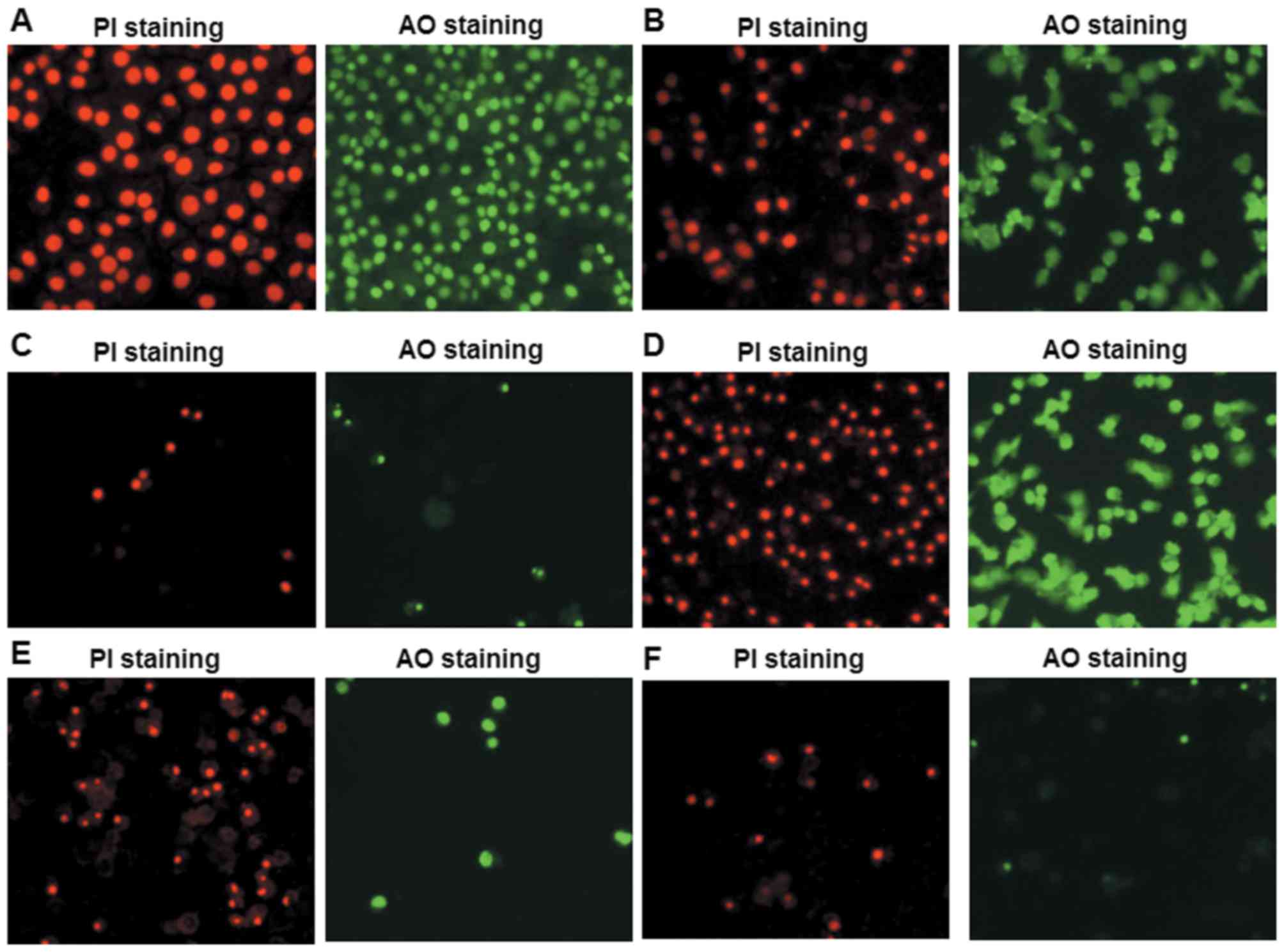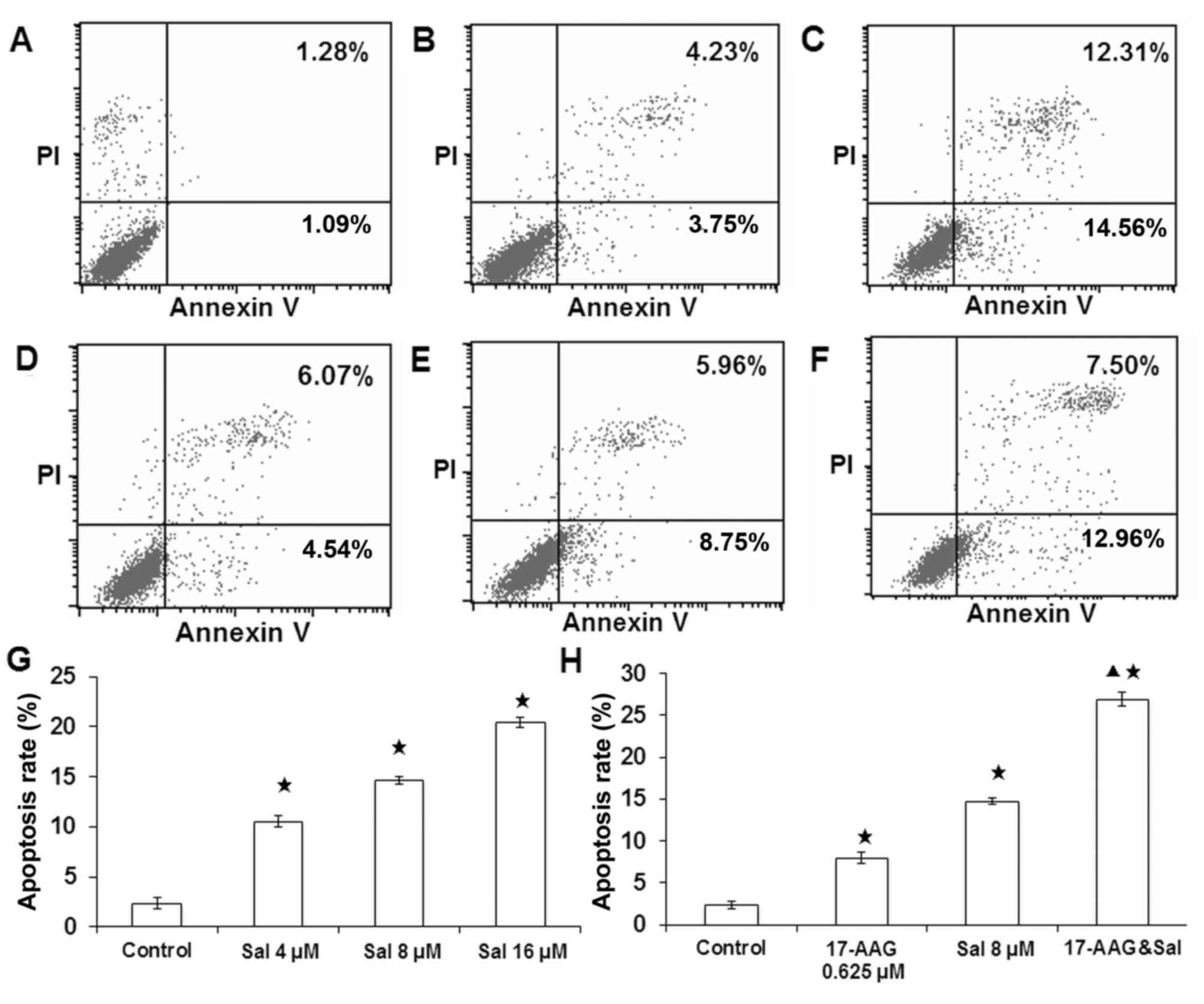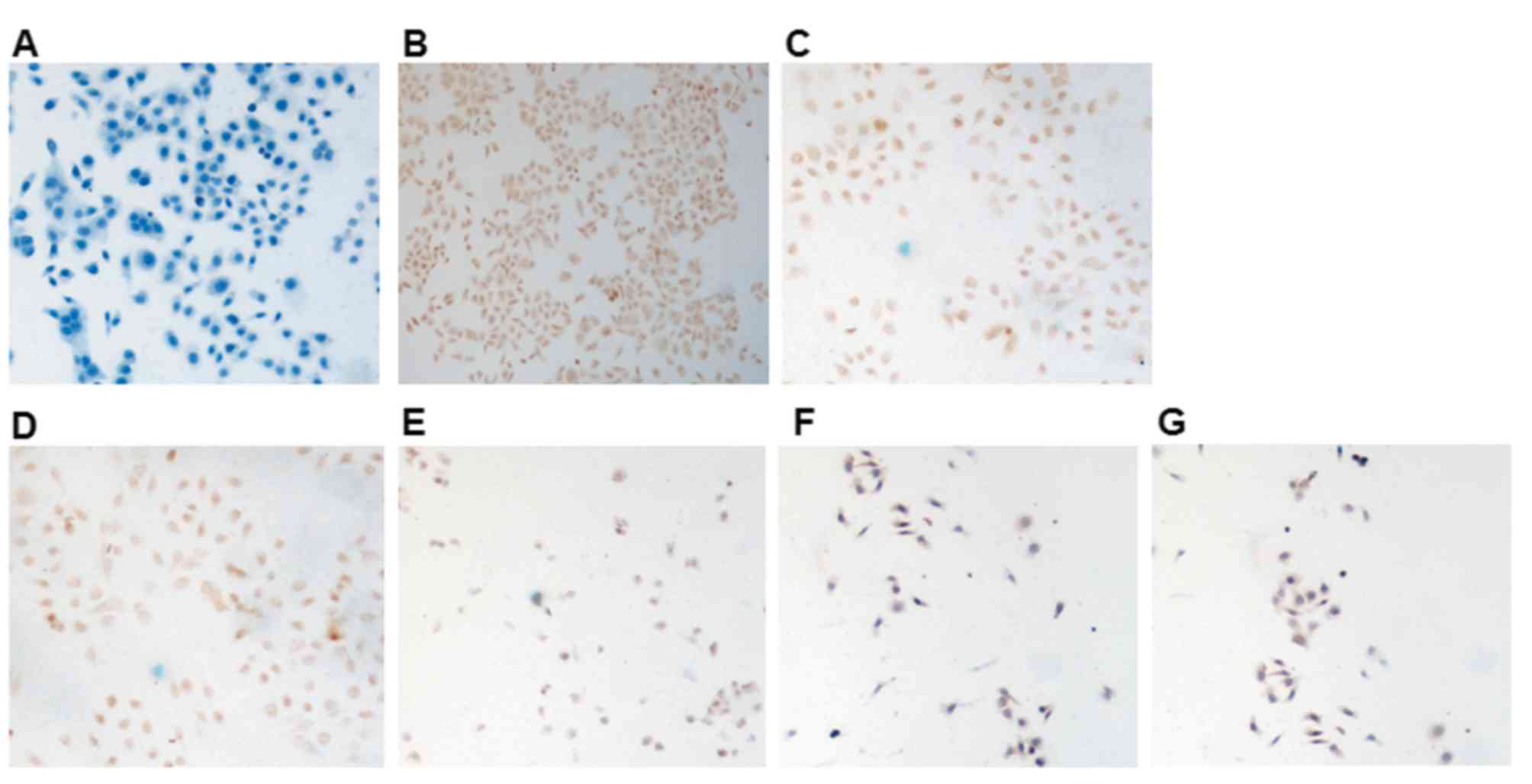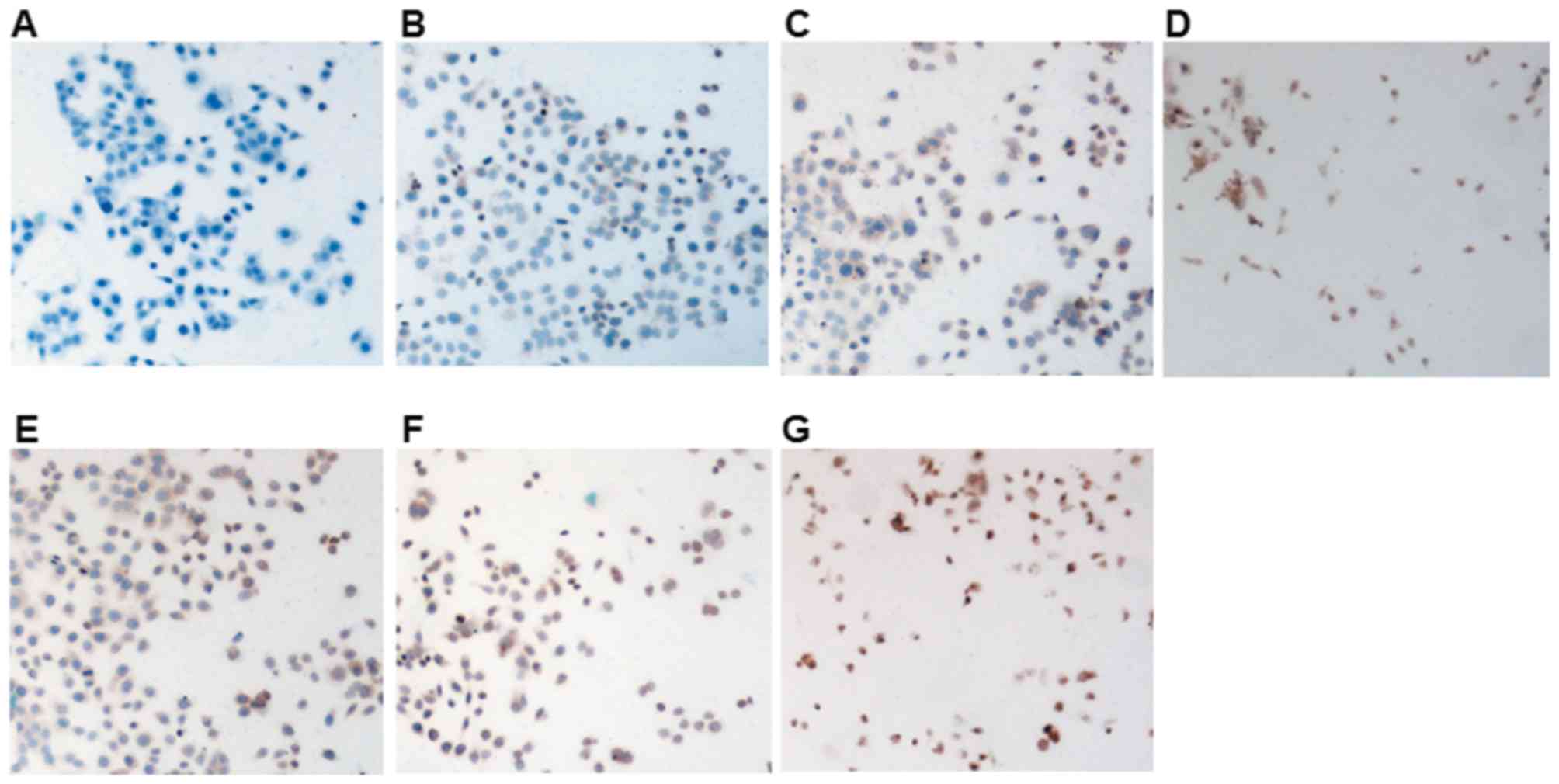Effects of salinomycin and 17‑AAG on proliferation of human gastric cancer cells in vitro
- Authors:
- Published online on: June 9, 2017 https://doi.org/10.3892/mmr.2017.6735
- Pages: 1063-1070
-
Copyright: © Zhang et al. This is an open access article distributed under the terms of Creative Commons Attribution License.
Abstract
Introduction
Gastric cancer is one of the most common malignancies worldwide with a mortality rate of >70%. East Asia, Eastern Europe and South America are considered to be areas with high incidences (1). The incidence of gastric cancer ranks second in China among malignant cancers (2,3). Furthermore, the overall incidence and mortality of gastric cancer is markedly increased in rural areas compared with urban areas, and gradually increases with age (4,5). Although the survival of gastric cancer patients is prolonged by effective treatment, the 5-year survival rate remains very low (~20 to 25%) (6). Radical gastric tumor resection combined with standard chemotherapy cannot remove the tumor completely, which has become a major issue in current cancer therapy (7).
Salinomycin is a type of carboxy-polyether type compound first extracted from the white Streptomyces albus by Japanese researchers in 1974 (8). Salinomycin is capable of neutralizing cations within cells, and exhibits good inhibitory and destructive effects on most gram-positive bacteria and all types of coccidian (9–11). Gupta et al (12) in 2009 revealed that the toxicity of salinomycin on breast cancer stem cells was 100 times that of the chemotherapeutic drug paclitaxel. In previous years, numerous studies have suggested that salinomycin exhibits anti-tumor effects; therefore, it may represent a novel and effective anticancer agent (9,13–19). However, high doses of salinomycin has high neurotoxicity (20). 17-allylamine-17-demathoxygeldanamycin (17-AAG), an inhibitor of heat shock protein (HSP) 90, shares an extremely similar structure with geldanamycin. 17-AAG exhibits a more effective toxicity profile (21,22). The anti-tumor effects of 17-AAG have also been widely recognized (23).
In order to reduce salinomycin dose and the associated toxicity, and to promote its use in cancer therapy, the present study investigated the effects of salinomycin and 17-AAG combined treatment on gastric cancer cells, which have not been previously reported. This study focused on the inhibition of salinomycin on proliferation of the SGC-7901 gastric cancer cell line, and the pro-apoptotic underlying mechanism of salinolycin. The present study aimed to provide a basis for the use of salinomycin in gastric cancer treatment, in addition to experimental evidence for understanding the mechanism underlying the anti-tumor effects of salinomycin.
Materials and methods
Reagents and instruments
Salinomycin was purchased from Sigma-Aldrich (Sigma-Aldrich; Merck KGaA, Darmstadt, Germany). 17-AAG and MTT were purchased from Sigma-Aldrich (Merck KGaA). RPMI-1640 medium was purchased from Thermo Fisher Scientific, Inc. (Waltham, MA, USA). Fetal bovine serum (FBS) was purchased from Zhejiang Tianhang Biotechnology Co., Ltd. (Zhejiang, China). Propidium iodide (PI) was purchased from Merck KGAa. Acridine orange (AO) was purchased from Amresco, LLC (Solon, OH, USA). An Annexin-fluorescein isothiocyanate (FITC)/PI Apoptosis kit was purchased from BD Biosciences (Franklin Lakes, NJ, USA). A DAB chromogenic kit, rabbit anti human nuclear factor (NF)-κB p65 polyclonal antibody (A00224) and rabbit anti human Fas-ligand (L) polyclonal antibody (BA0049) were purchased from GenScript Co., Ltd. (Nanjing, China), biotinylated goat anti rabbit IgG secondary antibody and horseradish peroxidase-labeled avidin secondary antibody were purchased from Wuhan Boster Biological Technology, Ltd. (Wuhan, China).
A carbon dioxide incubator was purchased from Sanyo Electric, Co. (Moriguchi, Japan). Fluorescence and inverted microscopes were purchased from Nikon Corporation (Tokyo, Japan). A flow cytometer was purchased from BD Biosciences. A microplate reader was purchased from Bio-Rad Laboratories, Inc. (Hercules, CA, USA).
Cell culture
The SGC-7901 human gastric cancer cell line was purchased from the Digestion Experimental Research Center of Xi'an Jiaotong University (Xi'an, China). Cells were cultured with RPMI 1640 medium supplemented with 10% FBS and 100 U/ml penicillin and streptomycin, and incubated in 5% CO2 at 37°C with 95% relative humidity.
MTT assay
SCG-7901 cells in the logarithmic phase were seeded into 96-well plates at a density of 1×105/ml with 100 µl RPMI 1640 medium per well. Cells were divided into four groups: Salinomycin treated (2, 4, 8, 16 and 32 µmol/l); 17-AAG treated (0.625 µmol/l); salinomycin (4, 8 and 16 µmol/l) combined with 17-AAG treated (0.625 µmol/l); and the control (complete RPMI 1640 medium). The total volume of each well was 100 µl and 5 duplicate wells were set for each group. After incubation for 24, 48 or 72 h, the supernatant was removed by centrifugation at 300 × g for 5 min at room temperature, and 20 µl MTT was added. After a 4-h incubation, MTT was removed and 150 µl dimethyl sulfoxide was added. The optical density at a wavelength of 495 nm was detected using a microplate reader. The experiment was repeated three times.
Morphology assay
SGC-7901 cell suspension was seeded into 6-well plates at a density of 2×105 per well. After incubation for 24 h, cells were treated with salionmycin (4, 8 or 16 µmol/l), 17-AAG (0.625 µmol/l), or salinomycin (8 µmol/l) combined with 17-AAG (0.625 µmol/l). Untreated cells served as the negative control. After a 48-h incubation, cell morphology was observed under an inverted phase contrast microscope. The above step was repeated three times.
Apoptosis assay
SGC-7901 cells were treated as described above, washed twice with PBS after a 48-h incubation, and then stained in the dark using PI or AO. Cell apoptotic morphology was observed using a fluorescent microscope.
In addition, cells were collected after trypsin digestion, washed twice with PBS, collected in Eppendorf (EP) tubes and stained with Annexin V-FITC and PI for 10 min. The cell apoptotic rate of each group was detected with a flow cytometer.
Cell cycle assay
Cells were seeded into 6-well plates and cultured for 24 h, and then cultured in RPMI 1640 medium supplemented with 0.5% FBS for synchronization. After a continuous culture for 24 h, cells were treated as for the morphology assay and cultured for 48 h. Cells were digested, collected, fixed in 70% alcohol for 30 min, centrifuged at 300 × g for 5 min at room temperature to remove the supernatant, washed with PBS and collected into an EP tube. PI (the working solution concentration was 50 µg/ml) staining was performed at 4°C for 30 min before a cell cycle assay was performed by flow cytometry.
Immunocytochemistry assay
SGC-7901 cells were treated as those mentioned in the morphology assay, washed with PBS three times after a 48-h incubation, and fixed with 4% paraformaldehyde for 20 min. Cells were then fixed with neutral balsam after drying, incubated with 0.3% Triton X-100 for 15 min at room temperature, and incubated with trypsin at 37°C for 30 min and H2O2 for 20 min at room temperature after PBS washing. Subsequently, cells were blocked with blocking reagent for 30 min and incubated with a rabbit anti human NF-кB p65 polyclonal antibody (1:100) or a rabbit anti human Fas-L polyclonal antibody (1:100) at 4°C overnight, followed by PBS washing. Following this, cells were incubated with a biotinylated goat anti rabbit secondary antibody (1:100) for 2 h, washed with TBS, incubated with a horseradish peroxidase-labeled avidin secondary antibody (1:100) for a further 30 min at room temperature, and washed three times with TBS. DAB was used for color development. Cells were re-stained with hematoxylin, differentiated with hydrochloric acid alcohol, dehydrated with alcohol, cleared with xylene, and mounted with neutral balsam. Cells were imaged under a Nikon E600 microscope and protein expressions were analyzed using NIS-Elements Documentation (Version 3.0.455) (both from Nikon Corporation, Tokyo, Japan). All the antibodies were diluted with PBS. Untreated cells incubated with PBS, instead of the primary antibodies, served as the secondary antibody control.
Statistical analysis
SPSS software version 22.0 (IBM SPSS, Armonk, NY, USA) was used for statistical analysis. All data are presented as the mean ± standard deviation. Comparison between groups was conducted by one-way analysis of variance, followed by Fisher's least significant difference post hoc test. P<0.05 was considered to indicate a significantly different difference.
Results
Salinomycin and 17-AAG alter SGC-7901 cell morphology
To determine the effect of salinomycin and 17-AAG on cell morphology, cells were treated with salinomycin, 17-AAG, or salinomycin+17-AAG, and cell morphology was observed under an inverted microscope. As presented in Fig. 1, untreated SGC-7901 cells exhibited adherent and tight growth with polygon or fusiform shapes, with a plump cytoplasm and tight connections between cells. However, after a 48-h treatment with salinomycin or 17-AAG, cell volume decreased. The cell membrane and nuclear membrane began to break and shrink. Cells grew slowly with increased gaps, and connections disappeared. Furthermore, the higher the salinomycin concentration, the more significant and severe alterations in SGC-7901 cell morphology, with reduced cell numbers. When cells were treated with salinomycin and 17-AAG together, the cell number and volume were further reduced; the cell cytoplasm condensed, and nuclei were further enriched and broken compared with groups treated with salinomycin or 17-AAG alone. These results indicated that salinomycin may alter SGC-7901 cell morphology when used alone or combined with 17-AAG.
Salinomycin and 17-AAG inhibits SGC-7901 cell proliferation in vitro
To evaluate the effects of salinomycin and 17-AAG on SGC-7902 cell proliferation, an MTT assay was conducted. The results demonstrated salinomycin inhibited SGC-7901 cell proliferation significantly in a time-dependent manner (24, 48 and 72 h) within a concentration range from 1 to 32 µmol/l, when compared with the control group (Fig. 2A; P<0.01). Furthermore, the cell proliferation inhibitory effects in cells following salinomycin treatment with the indicated concentrations (4, 8 and 16 µmol/l) were significantly increased compared with the control, salinomycin and 17-AAG groups when combined with 17-AAG (0.625 µmol/l) for indicated time points (24, 48 and 72 h; Fig. 2B-F; P<0.05). The results indicated that salinomycin may inhibit SGC-7901 cell proliferation in vitro, and enhance cell sensitivity to 17-AAG.
Salionomycin and 17-AAG inhibition of SGC-7901 cell cycle
To determine the effects of salinomycin and 17-AAG on SGC-7901 cell cycle, flow cytometry was performed (Fig. 3). The results demonstrated that after a 48-h treatment with salinomycin (4, 8 and 16 µmol/l) or 0.625 µmol/l 17-AAG alone (Fig. 3A and B; D-H), numbers of cells in G0/G1 phase were significantly decreased, whereas those in S phase were significantly increased compared with the control group (P<0.05). Additionally, when treated with 8 µmol/l salinomycin and 0.625 µmol/l 17-AAG, numbers of cells in S phase were significantly increased compared with the control, salinomycin and 17-AAG groups (Fig. 3C and H; P<0.05). These results suggested that salinomycin and 17-AAG may arrest cells in S phase, and that salinomycin combined with 17-AAG may enhance this effect on the cell cycle.
Salinomycin and 17-AAG induce SGC-7901 cell apoptotic morphology
To investigate the effects of salinomycin and 17-AAG on SGC-7901 cell apoptosis, PI and AO staining were performed and fluorescent microscope was used for detection (Fig. 4). As presented in Fig. 4A, cells in the control group grew well with uniform size, regular nuclei shapes, neat edges of nuclear membranes and regular chromatin distribution. Furthermore, cells exhibited typical red and green fluorescence signals after PI and AO staining, respectively (Fig. 4A). When treated with 17-AAG (Fig. 4B) or salinomycin (Fig. 4D-F) alone for 48 h, cell morphology altered significantly, including slower growth, reduced cell numbers, nuclei condensation, DNA enrichment near the nuclear membrane, apoptotic body formation, enhanced nuclear refraction and dense fluorescence, which were more obvious in groups treated with higher doses. Furthermore, when cells were treated with salinomycin and 17-AAG together for 48 h, cell apoptotic morphology altered more clearly compared with groups treated with salinomycin or 17-AAG alone (Fig. 4C). These results demonstrated that salinomycin and 17-AAG may induce SGC-7901 cell apoptotic morphology, and that the apoptosis was more severe when salinomycin and 17-AAG were used together.
Salinomycin and 17-AAG promotes SGC-7901 cell apoptosis
To identify whether salinomycin and 17-AAG could promote cell apoptosis in SGC-7901 cells, flow cytometry was performed. As presented in Fig. 5, compared with the control group (Fig. 5A), 48-h treatment with 0.625 µmol/l 17-AAG (Fig. 5B) or 4, 8, 16 µmol/l salinomycin (Fig. 5D-G) significantly increased SGC-7901 cell apoptosis (P<0.05). Furthermore, the 48 h co-treatment of 0.625 µmol/l 17-AAG and 8 µmol/l salinomycin significantly promoted cell apoptosis compared with the control and drug treatment alone groups (Fig. 5C and H; P<0.05). These results implied that both salinomycin and 17-AAG could promote cell apoptosis with a synergistic effect.
Salinomycin and 17-AAG activates the Fas/Fas-L signaling pathway while inhibiting the NF-κB pathway
To further elucidate the pro-apoptotic mechanism of salinomycin and 17-AAG, immunocytochemistry was conducted to detect the protein expression levels of NF-κB and Fas-L in SGC-7901 cells of each group; factors which serve important roles in tumorigenesis and pro-apoptosis, respectively.
Untreated cells incubated with PBS, in place of the primary antibody, served as the secondary antibody control (Fig. 6A). In untreated negative control cells, NF-κB expression was primarily identified in the nucleus and cytoplasm in control cells (Fig. 6B). In cells treated with 0.625 µmol/l 17-AAG (Fig. 6C) or salinomycin (4, 8 and 16 µmol/l; Fig. 6D-F, respectively), NF-κB expression was significantly decreased in both in the nucleus and cytoplasm. Furthermore, in cells treated with both 0.625 µmol/l 17-AAG and 8 µmol/l salinomycin (Fig. 6G), the decrease of NF-κB signal was more marked compared with the control, salinomycin and 17-AAG groups.
Fas-L expression was also detected by immunocytochemistry. No Fas-L expression was observed in the untreated secondary antibody control cells (Fig. 7A). Fas-L was expressed in the cytoplasm and membrane of untreated negative control cells (Fig. 7B). Fas-L expression was increased in the cytoplasm and membrane of cells treated with 17-AAG compared with control cells (Fig. 7C). In cells treated with both 17-AAG and salinomycin, increased Fas-L signals were observed both in the cytoplasm and nucleus (Fig. 7D). In cells treated with 4, 8 and 16 µmol/l salinomycin (Fig. 7E-G, respectively), Fas-L expression in the cytoplasm was increased, particularly in the 16 µmol/l salinomycin group (Fig. 7G), in which nuclear Fas-L signals were observed as well.
These results indicated that the pro-apoptotic effects of salinomycin and 17-AAG on SGC-7901 cells may be associated with activation of the Fas/Fas-l signaling pathway, and inhibition of the NF-κB signaling pathway.
Discussion
Gastric cancer is one of the most common types of malignant tumor (24). As an ionophore type antibiotic, salinomycin serves an important role in inhibiting tumor cell proliferation (9,13–19). However, the strong neurotoxic effects of salinomycin have been previously reported (20,25). 17-AAG is an inhibitor of HSP; its anti-tumor effect has already been widely accepted (26,27), and it has fewer side effects (21,22). The present study demonstrated that the combination of salinomycin and 17-AAG exhibited improved anti-tumor effects compared with treatment of one alone.
An et al (28) reported that salinomycin inhibits mammary stem cell proliferation via an apoptosis-independent pathway. Zhi et al (29) additionally demonstrated that salinomycin could selectively inhibit gastric cancer cells. The present study revealed that salinomycin inhibits SGC-7901 gastric cancer cell proliferation in a dose- and time-dependent manner within a certain concentration range, consistent with the previously mentioned studies. These results imply that salinomycin may induce apoptosis of gastric cancer cells. The present study additionally demonstrated that combination with 17-AAG could enhance the cell proliferation inhibitory effects of salinomycin significantly, and the sensitivity of SGC-7901 cells to 17-AAG. Notably, single and combined treatment of salinomycin and 17-AAG altered SGC-7901 cell morphology, particularly combined treatment. PI and AO fluorescent staining and flow cytometry results indicated that the apoptotic rate of cells treated with both salinomycin and 17-AAG together was significantly increased compared with cells treated with salinomycin or 17-AAG alone, implying that combination of these two agents could induce gastric cancer cell apoptosis synergistically. These results were consistent with a study by Liu et al (30), where salinomycin was identified to promote Jurkat cell apoptosis when used alone or combined with Vincristin. According to flow cytometry detection, salinomycin alone altered the cell cycle and prolonged S phase, and this effect was stronger when salinomycin was used together with 17-AAG. The potential mechanism may be the interference of DNA synthesis and replication. However, Zhang et al (31) demonstrated that salinomycin arrested the cell cycle of nasopharyngeal carcinoma cells at G2/M phase, while Parajuli et al (32) revealed that salinomycin could arrest cisplatin-resistant ovarian cancer cells at G1 phase. Therefore, the effect of salinomycin on cancer cell cycle requires further investigation.
The present study further investigated the mechanism underlying the pro-apoptotic effect of salinomycin and 17-AAG. NF-кB is an important nuclear transcription factor with numerous biological activities, including inflammation, viral infection, tumorigenesis and cancer progression (33,34). Fas/Fas-L are cell membrane molecules, and serve as pro-apoptotic factors in the death receptor signaling pathway (35,36). The specific binding of Fas/Fas-L may initiate pro-apoptitic signaling (37,38). Due to the important roles of NF-κB and Fas in apoptosis (39–43), it was hypothesized that the anti-tumor effects of salinomyin may be associated with these proteins. Parajuli et al (44) demonstrated that salinomycin could inhibit nuclear transport of NF-κB. Consistently, immunocytochemistry results of the present study revealed that salinomycin downregulated NF-κB protein expression, whereas upregulated Fas-L protein expression in SGC-7901 cells. Therefore, the pro-apoptotic effects of salinomycin and 17-AAG may be associated with inhibition of the NF-κB signaling pathway, and activation of the Fas/Fas-L signaling pathway.
In conclusion, the individual use of salinomycin and combined use with 17-AAG may significantly inhibit SGC-7901 gastric cancer cell proliferation and induce cell apoptosis. The potential mechanisms may be associated with upregulation of Fas-L and downregulation of NF-κB. These results provide a basis for the potential use of salinomycin in gastric cancer treatment.
Acknowledgements
The present study was supported by the National Natural Science Fund Grant (grant no. 81470140) and the Science and Technology Project of Education Department of Shanxi Province (grant no. 2013JK0783).
References
|
Jemal A, Bray F, Center MM, Ferlay J, Ward E and Forman D: Global cancer statistics. CA Cancer J Clin. 61:69–90. 2011. View Article : Google Scholar : PubMed/NCBI | |
|
Chen WQ, Zeng HM, Zheng RS, Zhang SW and He J: Cancer incidence and mortality in China, 2007. Chin J Cancer Res. 24:1–8. 2012. View Article : Google Scholar : PubMed/NCBI | |
|
Chen W, Zhang R, Zhang S, Zhao P, Li G, Wu L and He J: Report of incidence and mortality in China cancer registries, 2009. Chin J Cancer Res. 25:10–21. 2013.PubMed/NCBI | |
|
Chen WQ, Zheng RS, Zeng HM, Zhang SW, Zhao P and Hao J: Trend analysis and projection of cancer incidence in China between 1989 and 2008. Zhonghua Zhong Liu Za Zhi. 34:517–524. 2012.(In Chinese). PubMed/NCBI | |
|
Sjödahl K, Lu Y, Nilsen TI, Ye W, Hveem K, Vatten L and Lagergren J: Smoking and alcohol drinking in relation to risk of grastric cancer: A population-based, prospective cohort study. Int J Cancer. 120:128–132. 2007. View Article : Google Scholar : PubMed/NCBI | |
|
Niccolai E, Taddei A, Prisco D and Amedei A: Gastric cancer and the epoch of immunotherapy approaches. World J Gastroenterol. 21:5778–5793. 2015.PubMed/NCBI | |
|
Xu W, Yang Z and Lu N: Molecular targeted therapy for the treatment of gastric cancer. J Exp Clin Cancer Res. 35:12016. View Article : Google Scholar : PubMed/NCBI | |
|
Miyazaki Y, Shibuya M, Sugawara H, Kawaguchi O and Hirsoe C: Salinomycin, a new polyether antibiotic. J Antibiot (Tokyo). 27:814–821. 1974. View Article : Google Scholar : PubMed/NCBI | |
|
Daugschies A, Gässlein U and Rommel M: Comparative efficacy of anticoccidials under the conditions of commercial broiler production and in battery trials. Vet Parasitol. 76:163–171. 1998. View Article : Google Scholar : PubMed/NCBI | |
|
Danforth HD, Ruff MD, Reid WM and Miller RL: Anticoccidial activity of salinomycin in battery raised broiler chickens. Poult Sci. 56:926–932. 1977. View Article : Google Scholar : PubMed/NCBI | |
|
Mahmoudi N, de Julián-Ortiz JV, Ciceron L, Gálvez J, Mazier D, Danis M, Derouin F and García-Domenech R: Identification of new antimalarial drugs by linear discriminant analysis and topological virtual screening. J Antimicrob Chemother. 57:489–497. 2006. View Article : Google Scholar : PubMed/NCBI | |
|
Gupta PB, Onder TT, Jiang G, Tao K, Kuperwasser C, Weinberg RA and Lander ES: Identification of selective inhibitors of cancer stem cells by high-throughput screening. Cell. 138:645–659. 2009. View Article : Google Scholar : PubMed/NCBI | |
|
Naujokat C, Fuchs D and Opelz G: Salinomycin in cancer: A new mission for an old agent. Mol Med Report. 3:555–559. 2010. View Article : Google Scholar | |
|
Kopp F, Hermawan A, Oak PS, Ulaganathan VK, Herrmann A, Elnikhely N, Thakur C, Xiao Z, Knyazev P, Ataseven B, et al: Sequential salinomycin treatment results in resistance formation through clonal selection of epithelial-like tumor cells. Transl Oncol. 7:702–711. 2014. View Article : Google Scholar : PubMed/NCBI | |
|
Kim JH, Chae M, Kim WK, Kim YJ, Kang HS, Kim HS and Yoon S: Salinomycin sensitizes cancer cells to the effects of doxorubicin and etoposide treatment by increasing DNA damage and reducing p21 protein. Br J Pharmacol. 162:773–784. 2011. View Article : Google Scholar : PubMed/NCBI | |
|
Xiao Z, Sperl B, Ullrich A and Knyazev P: Metformin and salinomycin as the best combination for the eradication of NSCLC monolayer cells and their alveospheres (cancer stem cells) irrespective of EGFR, KRAS, EML4/ALK and LKB1 status. Oncotarget. 5:12877–12890. 2014. View Article : Google Scholar : PubMed/NCBI | |
|
Antoszczak M, Popiel K, Stefańska J, Wietrzyk J, Maj E, Janczak J, Michalska G, Brzezinski B and Huczyński A: Synthesis, cytotoxicity and antibacterial activity of new esters of polyether antibiotic-salinomycin. Eur J Med Chem. 76:435–444. 2014. View Article : Google Scholar : PubMed/NCBI | |
|
Kopp F, Hermawan A, Oak PS, Herrmann A, Wagner E and Roidl A: Salinomycin treatment reduces metastatic tumor burden by hampering cancer cell migration. Mol Cancer. 13:162014. View Article : Google Scholar : PubMed/NCBI | |
|
Huczynski A: Salinomycin: A new cancer drug candidate. Chem Biol Drug Des. 79:235–238. 2012. View Article : Google Scholar : PubMed/NCBI | |
|
Boehmerle W, Muenzfeld H, Springer A, Huehnchen P and Endres M: Specific targeting of neurotoxic side effects and pharmacological profile of the novel cancer stem cell drug salinomycin in mice. J Mol Med (Berl). 92:889–900. 2014. View Article : Google Scholar : PubMed/NCBI | |
|
Schulte TW and Neckers LM: The benzoquinone ansamycin 17-allylamino-17-demethoxygeldanamycin binds to Hsp90 and shares important biologic activities with geldanamycin. Cancer Chemother Pharmacol. 42:273–279. 1998. View Article : Google Scholar : PubMed/NCBI | |
|
Schnur RC, Corman ML, Gallaschun RJ, Cooper BA, Dee MF, Doty JL, Muzzi ML, Moyer JD, DiOrio CI, Barbacci EG, et al: Inhibition of the oncogene product p185erbB-2 in vitro and in vivo by geldanamycin and dihydrogeldanamycin derivatives. J Med Chem. 38:3806–3812. 1995. View Article : Google Scholar : PubMed/NCBI | |
|
Chen S, Chen X, Li Y, Yang S, Mo X, Zhang F, Mo K and Ding Y: Inhibitory effect of 17-AAG combined with paclitaxel on proliferation of esophageal squamous cell carcinoma Eca-109 cells in vitro. Nan Fang Yi Ke Da Xue Xue Bao. 35:844–847. 2015.(In Chinese). PubMed/NCBI | |
|
Wu HH, Lin WC and Tsai KW: Advances in molecular biomarkers for gastric cancer: miRNAs as emerging novel cancer markers. Expert Rev Mol Med. 16:e12014. View Article : Google Scholar : PubMed/NCBI | |
|
Song SP, Zhang XG, Wang M, et al: Changes and significance of serum creatine kinase and isoenzymes in salinomycin poisoning patients. Zhong Guo Wei Sheng Jian Yan Za Zhi. 21:28–29. 2011.(In Chinese). | |
|
Kim SH, Kang JG, Kim CS, Ihm SH, Choi MG, Yoo HJ and Lee SJ: 17-Allylamino-17-demethoxygeldanamycin and Herbimycin A induce cell death by modulating β-catenin and PI3K/AKT signaling in FRO anaplastic thyroid carcinoma cells. Anticancer Res. 35:5453–5460. 2015.PubMed/NCBI | |
|
Xu Y, Zhu Q, Chen D, Shen Z, Wang W, Ning G and Zhu Y: The HSP90 inhibitor 17-AAG exhibits potent antitumor activity for pheochromocytoma in a xenograft model. Tumour Biol. 36:5103–5108. 2015. View Article : Google Scholar : PubMed/NCBI | |
|
An H, Kim JY, Lee N, Cho Y, Oh E and Seo JH: Salinomycin possesses anti-tumor activity and inhibits breast cancer stem-like cells via an apoptosis-independent pathway. Biochem Biophys Res Commun. 466:696–703. 2015. View Article : Google Scholar : PubMed/NCBI | |
|
Zhi QM, Chen XH, Ji J, Zhang JN, Li JF, Cai Q, Liu BY, Gu QL, Zhu ZG and Yu YY: Salinomycin can effectively kill ALDH(high) stem-like cells on gastric cancer. Biomed Pharmacother. 65:509–515. 2011. View Article : Google Scholar : PubMed/NCBI | |
|
Liu PP, Zhu JC, Liu GX, Shui CX and Li XM: Salinomycin enhances the apoptosis of T-cell acute lymphoblastic leukemia cell line jurkat cells induced by vincristine. Zhongguo Shi Yan Xue Ye Xue Za Zhi. 23:653–657. 2015.(In Chinese). PubMed/NCBI | |
|
Zhang Y, Zuo Y, Guan Z, Lu W, Xu Z, Zhang H, Yang Y, Yang M, Zhu H and Chen X: Salinomycin radiosensitizes human nasopharyngeal carcinoma cell line CNE-2 to radiation. Tumor Biol. 37:305–311. 2016. View Article : Google Scholar | |
|
Parajuli B, Lee HG, Kwon SH, Cha SD, Shin SJ, Lee GH, Bae I and Cho CH: Salinomycin inhibits Akt/NF-κB and induces apoptosis in cisplatin resistant ovarian cancer cells. Cancer Epidemiol. 37:512–517. 2013. View Article : Google Scholar : PubMed/NCBI | |
|
Cai Z, Tchou-Wong KM and Rom WN: NF-kappaB in lung tumorigenesis. Cancers (Basel). 3:4258–4268. 2011. View Article : Google Scholar : PubMed/NCBI | |
|
Hayden MS and Ghosh S: Shared principles in NF-kappaB signaling. Cell. 132:344–362. 2008. View Article : Google Scholar : PubMed/NCBI | |
|
Wu GZ, Pan CX, Jiang D, Zhang Q, Li Y and Zheng SY: Clinicopathological significance of Fas and Fas ligand expressions in esophageal cancer. Am J Cancer Res. 5:2865–2871. 2015.PubMed/NCBI | |
|
Liu W, Xu C, Zhao H, Xia P, Song R, Gu J, Liu X, Bian J, Yuan Y and Liu Z: Osteoprotegerin induces apoptosis of osteoclasts and osteoclast precursor cells via the fas/fas ligand pathway. PLoS One. 10:e01425192015. View Article : Google Scholar : PubMed/NCBI | |
|
Deng Y, Feng P, Chen D, et al: Effects of Fas and Fas-L in cell apoptosis. Guo Wai Yi Xue Mian Yi Xue Fen Ce. 4:213–216. 1997.(In Chinese). | |
|
Wang Y, Wang C, Jiang C, Zeng H and He X: Novel mechanism of harmaline on inducing G2/M cell cycle arrest and apoptosis by up-regulating Fas/FasL in SGC-7901 cells. Sci Rep. 5:186132015. View Article : Google Scholar : PubMed/NCBI | |
|
Kong FC, Zhang JQ, Zeng C, Chen WL, Ren WX, Yan GX, Wang HX, Li QB and Chen ZC: Inhibitory effects of parthenolide on the activity of NF-κB in multiple myeloma via targeting TRAF6. J Huazhong Univ Sci Technolog Med Sci. 35:343–349. 2015. View Article : Google Scholar : PubMed/NCBI | |
|
Diab S, Fidanzi C, Léger DY, Ghezali L, Millot M, Martin F, Azar R, Esseily F, Saab A, Sol V, et al: Berberis libanotica extract targets NF-κB/COX-2, PI3K/Akt and mitochondrial/caspase signalling to induce human erythroleukemia cell apoptosis. Int J Oncol. 47:220–230. 2015.PubMed/NCBI | |
|
Gmeiner WH, Jennings-Gee J, Stuart CH and Pardee TS: Thymineless death in F10-treated AML cells occurs via lipid raft depletion and Fas/FasL co-localization in the plasma membrane with activation of the extrinsic apoptotic pathway. Leuk Res. 39:229–235. 2015. View Article : Google Scholar : PubMed/NCBI | |
|
Liu W, Lin YT, Yan XL, Ding YL, Wu YL, Chen WN and Lin X: Hepatitis B virus core protein inhibits Fas-mediated apoptosis of hepatoma cells via regulation of mFas/FasL and sFas expression. FASEB J. 29:1113–1123. 2015. View Article : Google Scholar : PubMed/NCBI | |
|
Li L, Yao YC, Fang SH, Ma CQ, Cen Y, Xu ZM, Dai ZY, Li C, Li S, Zhang T, et al: Pigment epithelial-derived factor (PEDF)-triggered lung cancer cell apoptosis relies on p53 protein-driven Fas ligand (Fas-L) up-regulation and Fas protein cell surface translocation. J Biol Chem. 289:30785–30799. 2014. View Article : Google Scholar : PubMed/NCBI | |
|
Parajuli B, Shin SJ, Kwon SH, Cha SD, Chung R, Park WJ, Lee HG and Cho CH: Salinomycin induces apoptosis via death receptor-5 up-regulation in cisplatin-resistant ovarian cancer cells. Anticancer Res. 33:1457–1462. 2013.PubMed/NCBI |



